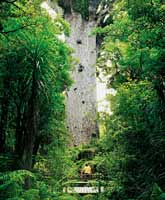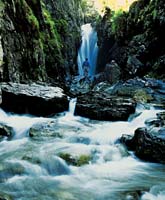New
Zealand Flora — Lush
and Diverse
|

Tane
Mahuta, the
largest Kauri
tree in New
Zealand,
dominates
Northland’s
Waipoua Forest. |
|
New Zealand’s high
rainfall and many sunshine
hours give the country a
lush and diverse flora — with
80 percent of the trees,
ferns, and flowering plants
being native. From the kauri
forests of the far north
to the mountain beech forests
and alpine tussock of the
Southern Alps, you’ll
find fascinating plants and
trees in every region. You’ll
be awed by the majestic evergreen
native forests that include
rimu, totara, many varieties
of beech, and the largest
native tree of them all,
the giant kauri. Underneath
the trees you’ll find
a dense and luxurious undergrowth
including countless native
shrubs, a variety of ferns,
and many mosses and lichens.
Splashes of Colour
The yellow flowers of the
kowhai tree are some of the
prettiest you’ll ever
see, and if you visit the
North Island, you won’t
be far from the beautiful
pohutukawa tree. Its bright
red flowers bloom in December,
giving it the title of New
Zealand’s Christmas
tree. |
|
FAST FACT:
New Zealand’s
most famous tree
is a kauri called
Tane Mahuta.
Named after the
Maori god of
the forests,
Tane Mahuta stands
over 51 metres
high, has a girth
of over 13 metres,
and is believed
to be over 2000
years old. |
|
|
National Parks
Over 20 percent of New Zealand
is covered in national parks,
forest areas and reserves.
Our 14 national parks contain
an incredible variety of
unspoiled landscape and vegetation.
Administered and maintained
by the Department of Conservation
Te Papa Atawhai, these parks
provide opportunity for a
wide variety of activities
including hiking, mountain
biking, skiing and snowboarding,
kayaking and trout fishing.
Most national parks have
excellent hiking tracks and
camping facilities, including
nearly 1000 huts throughout
the country. You’ll
also find information centres
at these parks, and helpful
signage along the tracks.
World Heritage Areas
The New Zealand mainland
has two World Heritage Areas — Tongariro
in the Central North Island
and Te Wahipounamu in the
south-west of the South Island.
Te Wahipounamu is made up
of four national parks — Westland/Tai
Poutini, Mount Aspiring,
Aoraki/Mount Cook and Fiordland.
The area also contains the
Milford and Routeburn tracks,
two of New Zealand’s
most spectacular walks, as
well as Mount Cook, New Zealand’s
highest mountain, and spectacular
glaciers. Tongariro is situated
on the North Island’s
volcanic plateau, and contains
the active volcanoes Mount
Tongariro, Ruapehu, and the
cone-shaped Ngauruhoe. The
area is of special cultural
significance to Maori, and
also contains Lake Taupo,
New Zealand’s largest
lake. |
|

A
scenic waterfall
in one of
New Zealand’s
many national
parks and
reserves. |
|
|